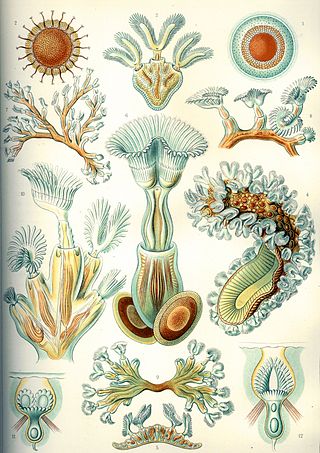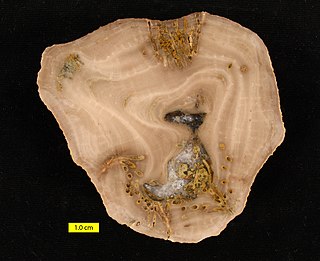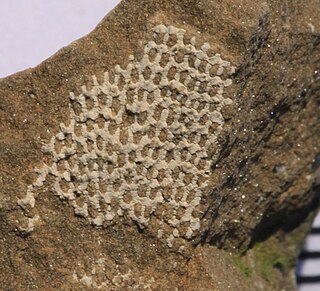Related Research Articles

Bryozoa are a phylum of simple, aquatic invertebrate animals, nearly all living in sedentary colonies. Typically about 0.5 millimetres long, they have a special feeding structure called a lophophore, a "crown" of tentacles used for filter feeding. Most marine bryozoans live in tropical waters, but a few are found in oceanic trenches and polar waters. The bryozoans are classified as the marine bryozoans (Stenolaemata), freshwater bryozoans (Phylactolaemata), and mostly-marine bryozoans (Gymnolaemata), a few members of which prefer brackish water. 5,869 living species are known. At least two genera are solitary ; the rest are colonial.
Stenolaemata are a class of exclusively marine bryozoans. Stenolaemates originated and diversified in the Ordovician, and more than 600 species are still alive today. All extant (living) species are in the order Cyclostomatida, the third-largest order of living bryozoans.

Trepostomatida is an extinct order of bryozoans in the class Stenolaemata. Trepostome bryozoans possessed mineralized calcitic skeletons and are frequently fossilized; some of the largest known fossilized bryozoan colonies are branching trepostomes and massive dome-shaped trepostomes. Trepostomes did not have many specialized zooecia beyond ordinary feeding autozooecia. The two main known heteromorphs are exilazooecia and mesozooecia, which had the purpose of maintaining regular spacing between autozooecia.
Ceramopora is an extinct genus of bryozoan of the family Ceramoporidae. It is one of the earliest genera of bryozoans. Its colonies were thin and discoid, with large autozooecia, abundant communication pores, lunaria, and monticules with depressions in their centers. It had no acanthostyles or diaphragms, distinguishing it from Acanthoceramoporella.

Amplexopora is a genus of bryozoans of the family Amplexoporidae, known in the rock record from the Ordovician to the Permian periods. Species belonging to this genus were stationary epifaunal suspension feeders. Their colonies showed a very great variety in shapes.

Fenestellidae is a family of bryozoans belonging to the order Fenestrida. The skeleton of its colonies consists of stiff branches that are interconnected by narrower crossbars. The individuals of the colony inhabit one side of the branches in two parallel rows or two at the branch base and three or more rows further up. Zooids can be recognized as small rimmed pores, and in well-preserved specimens the apertures are closed by centrally perforated lids. The front of the branches carries small nodes in a row or zigzag line between the apertures. Branches split from time to time giving the colonies a fan-shape or, in the genus Archimedes, create an mesh in the shape of an Archimedes screw.
Monticulipora is an extinct genus of Ordovician bryozoans belonging to the family Monticuliporidae. It was first named in 1849, and its description was published the following year by French paleontologist Alcide M. d'Orbigny, making it one of the earliest bryozoans to be recognized in science. It is still one of the most widespread fossil bryozoan genera. Though colonies that grow in masses made of multiple layers are characteristic of the genus, its colonies have varying shapes, able to be encrusting, branching, massive, or frond-like, and are covered in monticules (bumps). Most Monticulipora species have distinctively granular walls, and Monticulipora and can be distinguished from Homotrypa by the presence of axial diaphragms.
Dekayia is an extinct genus of Ordovician bryozoans of the family Heterotrypidae. Its colonies can be branching, encrusting, or massive. All species have acanthopores in varying sizes and numbers. The autozooecia appear angular or sub-angular viewed through a cross-section of the colony, and their walls are distinctively undulating or crenulated. Maculae generally protrude from the colony surface very little or at all, and can contain unusually large autozooecia and a cluster of mesozooecia in their centers.
Homotrypa is an extinct genus of bryozoans from the Ordovician and Silurian periods, known from fossils found in the United States. Its colonies are branch-like and have small monticules made of groups of three or four larger zooecia slightly protruding out from the main surface of the colony. In cross section, the zooecia are erect in axis and gently curve toward the surface of the colony.
Mesotrypa is a genus of bryozoans known from the Ordovician period, first described in 1893. Its colonies consist of low masses, wider than they are thick, made of superimposed layers, with small monticules on the surface of the colony.
Dianulites is an extinct genus of bryozoans from the early Ordovician period, belonging to the family Dianulitidae. Its colonies can be turbinate, horn-shaped, conical, or massive and hemispherical. Individual zooecia take the form of long, thin-walled polygonal tubes. It lacks styles (acanthopores), which helps differentiate it from similar genus Nicholsonella.
Lunaferamita is an extinct genus of cystoporate bryozoans of the family Constellariidae, known from the Middle Ordovician. It is distinct from other Constellariidae due to the presence of a lunarium, a quality distinctive to cystoporates. Like other Constellariidae, such as Constellaria, it has star-shaped monticules (bumps) on the surface of its colonies.
Prasopora is an extinct genus of bryozoan belonging to the family Monticuliporidae, known from the Middle Ordovician. Its colonies were disc-shaped or hemispherical, flat on bottom and convex on top, and had very abundant mesopores; in the case of the species P. insularis its zooecia were isolated from each other by the numerous mesopores surrounding them. It is very similar to the genus Monticulipora, and some bryozoan species have been assigned to both genera at different points in their study, but it is mostly distinguished by having more mesozooecia, rounder autozooecial apertures, relatively few acanthostyles and diaphragms and cystiphragms equally distributed in the autozooecia.
Cyphotrypa is an extinct genus of Ordovician bryozoan. Its colonies form hemispherical shapes, with flat undersides and rounded tops. In cross-section, the zooecia fan out from the initial growth area and intersect the rounded top surface of the colony at right angles. A few scattered maculae are present, composed of a few zooecia larger than the others with mesopore-like apertures.
Hemiphragma is an extinct genus of Middle Ordovician bryozoan. It had branching colonies with thick-walled zooecial apertures and lots of acanthopores, but few mesopores.
Nicholsonella is an extinct genus of bryozoans of uncertain taxonomic placement. Its colonies can take the forms of thick branching masses or branches.
Arthrostyloecia is an extinct genus of bryozoan of the family Arthrostylidae, that lived in the Ordovician period. Its colonies are articulated, distinctively containing ball and socket joints. It contains a single species, Arthrostyloecia nitida.
Kukersella is an extinct genus of bryozoan of the family Crownoporidae, known from the Ordovician period. Its colonies consist of cylindrical branches growing from an encrusting base.
Crassaluna is an extinct genus of cystoporate bryozoan of the family Anolotichiidae, known from the Ordovician period. It had an encrusting growth habit or, in the case of C. fungiforme, formed cup-shaped colonies. Its colonies possessed a vesicular skeleton and monticules. Its cyst-like interzooecial spaces are a distinguishing feature.
Dybowskites is an extinct genus of bryozoan of the family Ralfimartitidae, found in the Ordovician and Silurian periods. It forms branching, frond-like, or sometimes segmented colonies. In cross-sections of the colonies, the tubular autozooecia are seen growing alongside the branch axis and then bending abruptly to reach the colony surface at a perpendicular angle. There are many mesozooecia and large acanthostyles that protrude from the colony surface.
References
- 1 2 "Genus Eridotrypa Ulrich, 1893". FOSSIILID.INFO. Retrieved 26 February 2022.
- ↑ Loeblich, Alfred R. (July 1942). "Bryozoa from the Ordovician Bromide Formation, Oklahoma". Journal of Paleontology. 16 (4): 429–430.
- ↑ Nickles, John M; Bassler, Ray Smith (1900). A synopsis of American fossil Bryozoa, including bibliography and synonymy (PDF). Department of the Interior, United States Geological Survey. p. 32-33.
- ↑ Ernst, Andrej; Key, Marcus (2007). "Upper Ordovician Bryozoa from the Montagne de Noire, Southern France". Journal of Systematic Palaeontology. 5 (4): 392. Bibcode:2007JSPal...5..359E. doi:10.1017/S1477201907002155. S2CID 85115257.